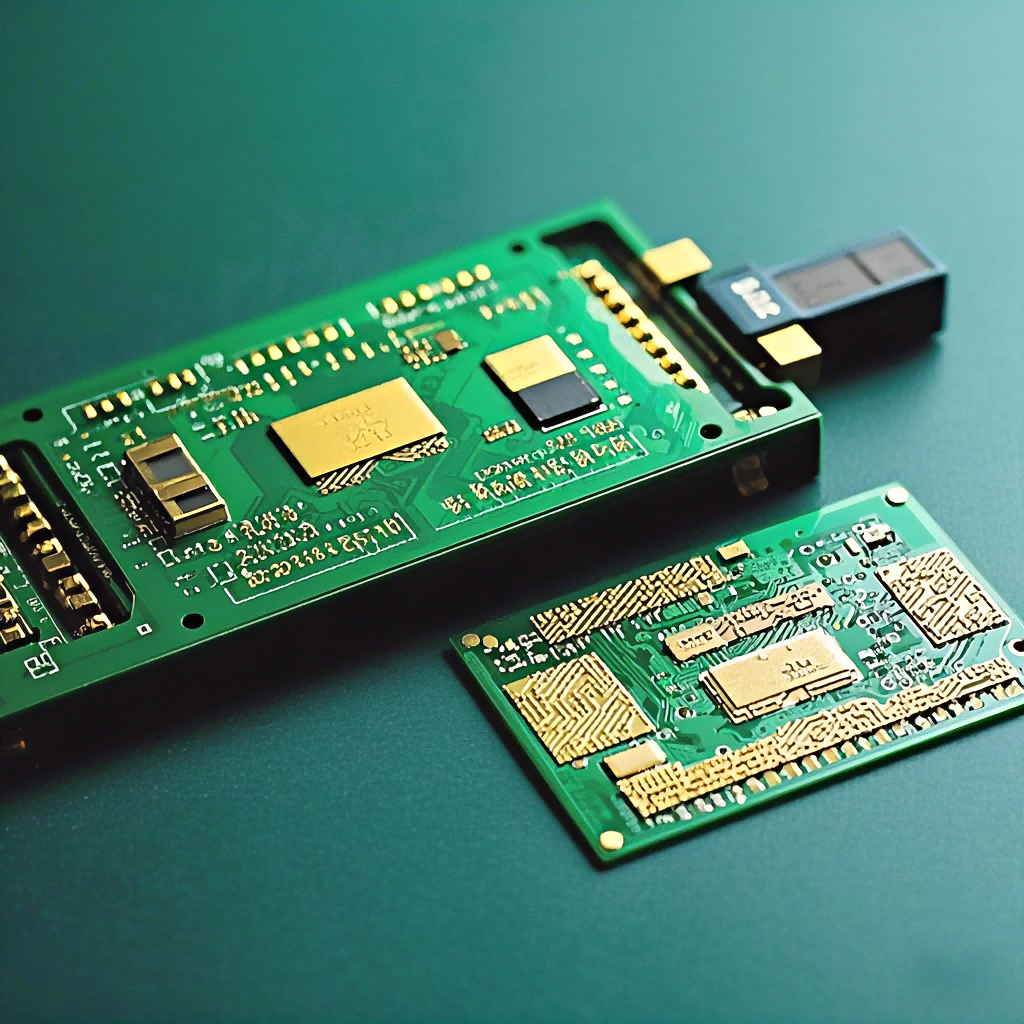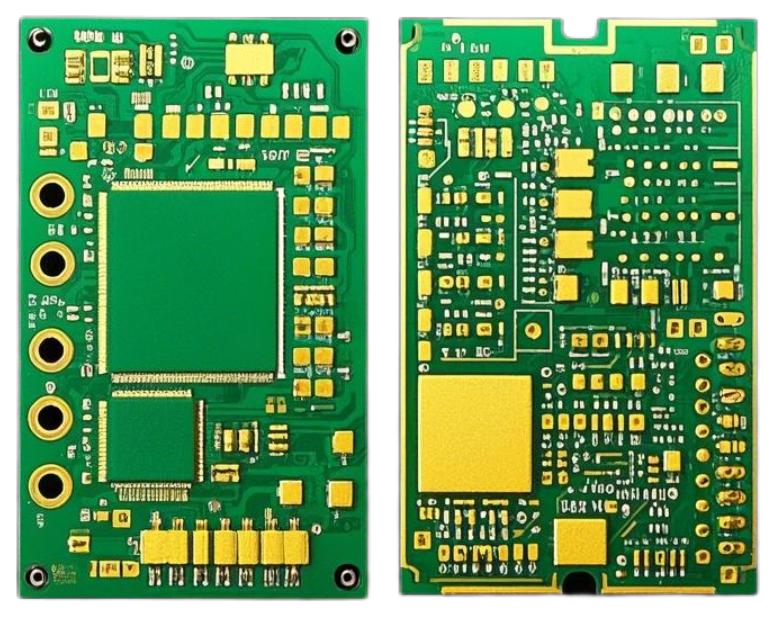Search
Unraveling the Mysteries of Gold Plating and Chemical Gold in PCB Fabrication
- Jan 10,2025
-
Share
Hey there, tech aficionados and PCB pros! Welcome back to our blog where we dig deep into the fascinating world of printed circuit board manufacturing. Today, we're shining a spotlight on two crucial surface finishing techniques: gold plating and chemical gold, and exploring the nuances that set them apart.

1. The Science Behind the Processes
Gold Plating: Electrochemical Alchemy
In the realm of gold plating, which is predominantly electrochemical in nature, we enter the domain of electroplating. Picture this: a bath filled with an electrolyte solution, rich in gold complexes like potassium gold cyanide – a staple in the plating world. Our PCB, acting as the cathode, is submerged into this solution. When an electric current is meticulously applied, gold ions, positively charged and eager to transform, are drawn towards the cathode. As they reach the surface of the copper traces and pads on the PCB, these ions snatch up electrons and undergo a reduction reaction, metamorphosing into solid gold atoms. This process, akin to a microscopic construction site, builds up a layer of gold with precision and control. The ability to fine-tune parameters such as current density, measured in amps per square decimeter (A/dm²), and plating time, in minutes or even seconds, allows engineers to craft gold layers of varying thicknesses, typically ranging from a feather-light 0.025 μm to a more substantial 0.75 μm or beyond.
Chemical Gold: The Chemical Concerto
Chemical gold, on the other hand, takes a different route. It's a symphony of chemical reactions that doesn't rely on an external electrical current. Instead, we have a carefully formulated chemical solution, often containing reducing agents like hypophosphite or sodium borohydride. These agents are the maestros that orchestrate the reduction of gold ions present in the solution. In this non-electric dance, the gold ions and reducing agents interact spontaneously. As the reaction unfolds, gold atoms gradually deposit onto the PCB surface, creating a thinner yet functional gold veneer. The thickness of this chemically deposited gold layer usually hovers around 0.03 - 0.1 μm, sufficient for many applications where a delicate touch of gold is needed.
2. Characteristics: Gold Layers Under the Microscope
Gold Plating: Robust and Resilient
The gold layer formed through electroplating is a marvel of engineering. Its crystalline structure is relatively dense, with grains that are fine and well-ordered. This translates to excellent electrical conductivity, measured in Siemens per meter (S/m), which is vital for high-speed digital and high-frequency analog circuits. In applications like RF (Radio Frequency) modules and high-speed data buses, where every milliohm of resistance matters, a thick, well-plated gold layer can mean the difference between seamless signal transmission and frustrating losses. Additionally, its durability is second to none. When it comes to connectors and sockets that endure countless insertions and removals, the abrasion resistance of electroplated gold ensures a long lifespan and reliable connections.
Chemical Gold: Subtle yet Sufficient
Chemical gold, while not as thick as its electroplated counterpart, has its own charm. The gold layer, though thinner, still provides a crucial barrier against oxidation for the underlying copper. This is especially critical for solder pads, where the moment of truth comes during the soldering process. The chemical gold layer ensures that the copper beneath remains pristine until the molten solder makes contact, allowing for excellent wetting and a strong bond. In the world of microelectronics, where miniaturization is the name of the game, and cost-efficiency is key, this thin layer of gold gets the job done without adding unnecessary bulk or expense.
3. Real-World Applications: Where Do They Shine?
Gold Plating: Powering High-Performance Circuits
For applications that demand the utmost in electrical performance, gold plating is the go-to choice. In aerospace and defense electronics, where reliability in extreme conditions is non-negotiable, thick gold layers on critical circuitry safeguard against cosmic radiation-induced conductivity changes and harsh environmental factors. Similarly, in high-end medical devices, such as implantable electronics and diagnostic equipment, the low impedance and long-term stability of electroplated gold are essential for accurate readings and patient safety. Even in the high-octane world of telecommunications, base stations and satellite communication systems rely on gold-plated components to handle the torrents of data with minimal signal degradation.
Chemical Gold: Perfecting the Solder Joint
In the bustling factories churning out consumer electronics, chemical gold reigns supreme in the realm of solder pads. Smartphones, tablets, and wearable devices all benefit from the precise and cost-effective application of chemical gold. It allows for rapid, high-quality soldering during the assembly process, reducing production time and defects. Chip-scale packages, where the connection between the chip and the PCB is a matter of micrometers, rely on the thin chemical gold layer to create a seamless interface. This ensures that the delicate circuitry within these tiny powerhouses functions flawlessly, delivering the performance consumers expect.
4. Cost Considerations: Balancing the Books
Gold Plating: Investment for Excellence
Gold plating doesn't come cheap, and for good reason. The equipment required is a veritable arsenal of high-tech gear. Electroplating tanks, made of corrosion-resistant materials, must be precisely temperature-controlled. Rectifiers, capable of supplying stable and adjustable currents, are the heart of the operation. Add to that the continuous consumption of electricity during the plating process, which can be significant depending on the volume of production. And of course, the gold salts themselves, which are costly reagents, factor heavily into the cost equation. But for applications where performance is king, the investment pays off in reliability and longevity.
Chemical Gold: Cost-Effective Alternative
Chemical gold offers a more budget-friendly option. The setup is relatively modest, requiring containers for the chemical solution, heating elements to maintain the optimal reaction temperature, and perhaps some agitation equipment to ensure uniform deposition. The gold usage is considerably less due to the thinner layers, and while the chemical reagents still have a cost, it's a fraction of what's spent on gold plating. This makes it an attractive choice for mass-produced consumer electronics, where cost control is as important as functionality.
5. The Art of Process Mastery
Gold Plating: Precision and Patience
Mastering the gold plating process is akin to a delicate art form. Engineers must meticulously monitor and adjust parameters. Pretreatment steps, such as degreasing to remove any contaminants and micro-etching to roughen the copper surface for better adhesion, are crucial. During plating, any fluctuations in current density or temperature can lead to defects like porosity in the gold layer or uneven thickness distribution. Post-plating cleaning is equally important to remove any residual salts and ensure the integrity of the gold finish. And with the use of hazardous chemicals and high voltages, strict safety protocols must be in place to protect the operators.
Chemical Gold: Consistency is Key
Chemical gold plating, while seemingly simpler, has its own set of challenges. Maintaining the stability of the chemical solution is a constant battle. The concentration of reducing agents, gold ions, and other additives must be carefully calibrated. Reaction time and temperature need to be tightly controlled to achieve a uniform gold layer. Any deviation can result in color variations, thickness discrepancies, or even incomplete coverage. But when done right, it can produce reliable results at a fraction of the complexity and cost of gold plating.

Here at Shenzhen Huaruixin Electronics Co., Ltd., we've been navigating these waters for years, leveraging our expertise in both gold plating and chemical gold to deliver top-notch PCBs. Whether you're a startup dreaming up the next big thing in tech or an established enterprise looking to optimize your PCB production, we're here to partner with you. Let's start a conversation, share ideas, and build better circuits together! Until next time, keep exploring the electrifying world of PCB manufacturing.

Let’s talk! We’ll provide the perfect solution for you!
-
 Huaruixin Electronics mainly produces printed circuit boards as the core business, to provide customers with one-stop solutions for FPC/PCB production, components sourcing and Assembly.
Huaruixin Electronics mainly produces printed circuit boards as the core business, to provide customers with one-stop solutions for FPC/PCB production, components sourcing and Assembly. - WHAT WE DO — PCB Design Solutions — Flex PCB Production — Components Sourcing — FPC&PCB Assembly
- PRODUCTS — Single Sided Flexible Circuits — Double Sided Flexible Circuits — Multilayer Flexible Cirucits — Rigid-Flex Circuits — FPC Assembly — PCB Assembly
- CAPABILITY — FPC Capability — Rigid-Flex Capability — PCB Capability — Assembly Capability
- Copyright © 2024 Shenzhen Huaruixin Electronics Co., Ltd. All Rights Reserved.
- Design By BONTOP


